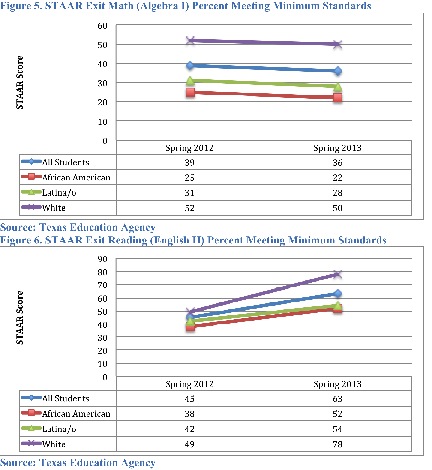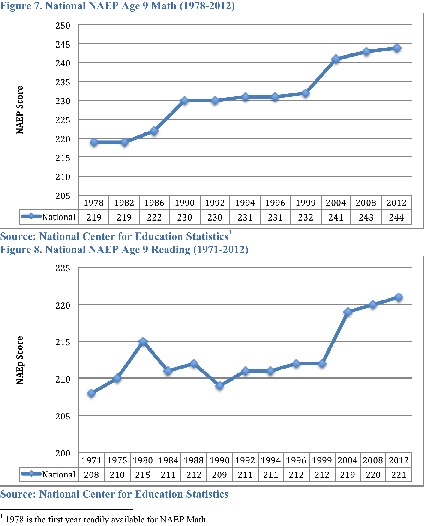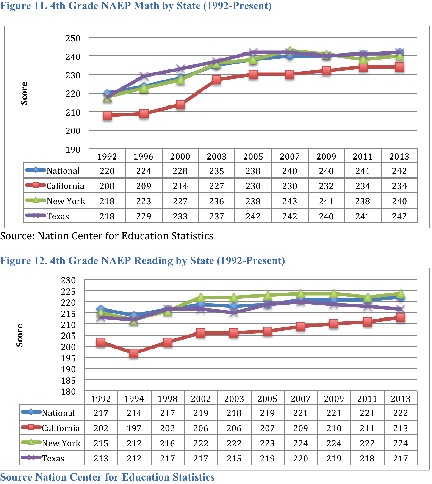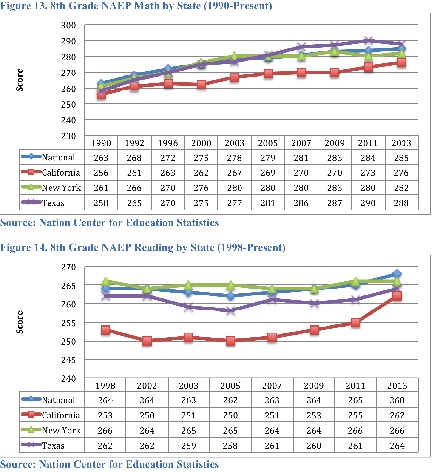Cloaking Inequity: Were Kids Actually Smarter Decades Ago?: Student Achievement Data Trends (NAEP, etc.)

To understand the success and failures of public education in United States and Texas (as measured by achievement tests), I ask the following research questions in this post: How do the nation’s public schools perform on the NAEP over the past several decades? Were kids actually smarter 30 years ago in the U.S? Also, how does Texas perform on state-mandated exams and compare to the nation and peer states (California and New York) over the past several decades in national achievement data? To answer these questions, first I examine K-12 achievement data from the TAAS, TAKS, and STAAR— the succession of state-mandated exam regimes in Texas. I then utilize data from the NAEP to examine national trends on the NAEP over the last several decades (Spoiler Alter: Our kids in public schools aren’t as stupids (sic) as we are told by the media and school “reformers”). Then, I rank the Lone Star State on the NAEP relative to all U.S. states and its most comparable peer states (California and New York). For international comparisons between all U.S. states and the world see the post Who’s Smarter Than Texans: Math and Science Test Scores Compared to the World and Nation Note: Lest you believe I have become enamored with high-stakes tests, in a post later this week I will discuss our nation’s obsession with measuring outputs via high-stakes tests relative to inputs (school finance).

First, let’s start with Texas data (skip these sections if you don’t giving a flying into Fukushima Airport about Texas), then I will move to the national data and comparisons.
Texas Assessment of Academic Skills (TAAS)
Figure 1 shows that for All Students, the percent of students passing went from 55 percent in 1994 to 92 percent by 2002. African Americans increased their achievement on the TAAS Exit Math, from only 32 percent meeting minimum standards in 1994 to 85 percent by 2002. Concurrently, the percent of Latina/os meeting minimum standards increased from 40 percent to 88 percent. Although the achievement gap between minorities and whites remained, the gap for Latina/os and African Americans narrowed to 8 percent and 11 percent, respectively, by 2002.
Figure 2 shows a gain of 19 percentage points for All Students between 1994 and 2002. For African Americans, the percent of students passing went up by the largest margin, a 32-percentage point gain. Latina/o students meeting minimum standards on the TAAS Exit Reading increased by 29 percentage points. In sum, by 2002, the Texas Education Agency (TEA) reported that 92 percent of African Americans and 90 percent of Latina/os in the state had met minimum standards on the TAAS Exit Reading. Whites increased by 12 percentage points by 2002. The gap in percent passing closed to 8 percent for Latina/os and 6 percent for African Americans.
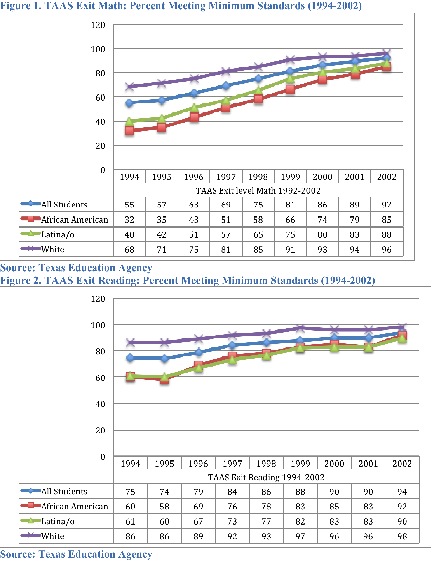
Texas Assessment of Knowledge and Skills (TAKS)
In 2003, the TAKS replaced the TAAS as the exit exam in Texas. As shown in Figure 3, between 2003 and 2011 the percentage of African Americans passing the TAKS Exit Math increased from 25 percent to 83 percent, a gain of 58 percentage points. Latina/os showed a similar gain of 58 percentage points in students meeting minimum standards on the TAKS Exit Math (from 30% to 88%). Similar to the closing of the achievement gap on the TAAS Exit Math, the TAKS Exit Math gap for African Americans and Latina/os decreased to 12 and 7 percentage points by 2010.
During the first eight years of TAKS Exit testing, the percentage of African Americans passing the TAKS Exit English Language Arts increased 43 percentage points, while the proportion of Latina/os meeting minimum standards increased 38 percentage points (see Figure 4). Similar to the closing of the achievement gap noted on the TAAS Exit Reading, the gap between African American and White students decreased to 6 percentage points. By 2010, the gap between the percent of Whites and Latina/os passing the TAKS Exit English Language Arts had declined to 7 percentage points.
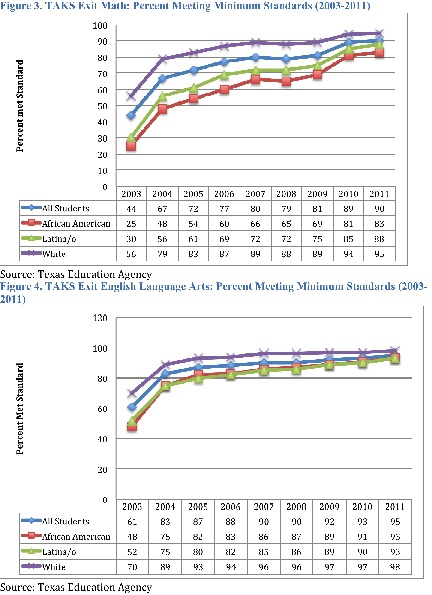
State of Texas Assessments of Academic Readiness (STAAR)
In 2011, the STAAR replaced the TAKS as the state assessment system in Texas. The number of exit tests was raised from four under TAKS to 15 End-of-Course (EOC) exams. For consistency, I will consider English II and Algebra I, courses usually taken in the Sophmore or Junior year. The standards for passing on the STAAR exams were set relatively low for English II and Algebra I in year one— similar to the TAAS and TAKS eras. Dissimilar to the TAAS and TAKS outcomes, the scores for All Students dropped between the first and second administrations of the STAAR Algebra I exam. Both African American and Latina/o students performed three percentage points worse across the state between 2012 and 2013. Whites also dropped two percentage points (See Figure 5).
Compared to the Algebra I EOC, the results were better for English II In 2012— All Students increased their scores by 18 percentage points between years (See Figure 6). The percent of African Americans meeting minimum standards on the English II STAAR increased by 14 percentage points. Latina/os also increased their scores, improving 12 percentage points from 42 percent to 54 percent meeting minimum standards.

Summary of Texas State Assessment Data. Exit-exam results show that African American and Latina/o students made large achievement gains and narrowed the achievement gaps during the TAAS and TAKS eras. The baseline exit scores were initially quite low in the TAAS and TAKS testing eras. However, Texas exit exam data have typically shown that African American and Latina/o students have made incremental achievement gains in English language arts and math. Each generation of state-mandated high-stakes testing has supported a narrative that the achievement gap narrowed. In the case of the TAAS, it nearly closed. The STAAR Algebra I is currently an anomaly to the upward trends noted in each testing era— as the results have for the first time shown a large decrease in percent passing year over year in math. So the question that comes to mind is: Do we see the same dramatic achievement trends in the national NAEP test?
National Tests: Achievement Data Trends
First, it is important to note that there is wide variability amongst state-mandated criterion-referenced tests (i.e. STAAR).[i]Achieve, Inc. compared state high-stakes test proficiency levels with those set by the National Assessment for Educational Progress (NAEP), a federally funded achievement test viewed as a comparable assessment to most state tests.[ii]When it came to fourth grade math performance, states varied widely in how they defined “proficient.” For example, compared to NAEP’s standard of proficiency, Mississippi’s tests were the easiest compared to NAEP standards, whereas Massachusetts’ assessments were much harder.

As a result it is important to analyze how Texas students performed over the past several decades not only on state assessments , but also on NAEP, ACT, and SAT tests, which represent independent national standards for levels of proficiency (For an analysis of SAT and ACT data check out Education Outcomes: Texas vs. California vs. New York vs. Nation). Examining the NAEP and other national test results also allows comparison of Texas’ educational outcomes to our nation’s other most populous states. In the forthcoming section I examine NAEP national and state outcomes for all students.[iii]
National Assessment of Educational Progress (NAEP)
The National Center for Education Statistics (NCES) reported that the idea of a national assessment gained impetus in the early 1960s. NAEP planning began in 1964, with a grant from the Carnegie Corporation to set up the Exploratory Committee for the Assessment of Progress in Education (ECAPE) and was followed by the appointment of the Technical Advisory Committee (TAC) in 1965.[iv] The first NAEP assessments were held in 1969.[v]Voluntary assessments for the states began in 1990 on a trial basis and were made a permanent feature of NAEP every two years.
The analysis begins with the national NAEP score trends across the entire nation for math and reading since the 1970s. What is notable about Figures 7-10 is that the achievement of students across the United States has improved for reading and math over the past two decades at ages 9 and 13.[vi]For example, Figure 7 shows that average Age 9 NAEP math scores have risen 25 points since 1978. The nation has also experienced a large rise in long term scores on Age 9 NAEP reading examination (See Figure 8). The scores increased from 208 in 1971 to 221 in 2012— an increase of 13 points over three decades. Notably, Age 9 reading scores have not increased as much as the Age 9 math scores across the nation since the 1970s.
[vii]
Similar to Age 9 test results, the nation has also experienced a large rise over time in scores on the NAEP at age 13. Figure 9 shows that the Age 13 NAEP math has risen 21 points since 1978. On the Age 13 NAEP reading, the scores increased from 255 in 1971 to 263 in 2012— an increase of 8 points over three decades (See Figure 10). Similar to the Age 9 NAEP score trends over the past three decades, the Age 13 reading scores have not increased as much as the Age 13 math scores since the 1970s.
[viii]
Turns out American kids are getting smarter, not dumber. Who’d have thunk it’?
The analyses now turn to comparison of NAEP state-level scores in the three largest states.[ix] Figure 11 shows that 4th grade math scores across the U.S. improved 22 points between 1992 and 2013. Notably, California improved 26 points, the most over the last two decades. Texas outscored California and New York in 1992 and 2013. However, New York has nudged past Texas during various points over the past two decades. Of note, among the most populous states Texas was the only one at the national average.
Figure 12 shows that the Golden State’s scores were the lowest initially on the 4th grade NAEP reading, but California again showed the most improvement over the past two decades (11 points). Overall, New York had the highest 4th grade NAEP reading scores in both 1994 and 2013— and among the most populous states was the only one above the national average. By comparison, the 4th grade NAEP math scores have increased more and are higher than 4th grade NAEP reading scores over the past two decades.
Tables 1 and 2 show where the three most populous states rank on the NAEP relative to the other 50 states during the first decade of this century. On the 4th grade NAEP math, all three of the largest states saw their relative standing to other states drop. While New York and California had modest declines, Texas saw its ranking drop the most— 21 spots between 2000 and 2009, as Texas moved from 6th to 27th in the nation. On 4th grade NAEP reading, all states also lost ground. California (41st to 48th) dropped the most (7 spots), while Texas (29th to 33rd) and New York (12th to 15th) declined four and three spots, respectively.
Table 1. National Rank: 4th Grade NAEP Math by State
|
State |
2000 |
2009 |
Δ |
|
Texas |
6 |
27 |
-21 |
|
California |
40 |
45 |
-5 |
|
New York |
22 |
26 |
-4 |
Source: National Center for Education Statistics, 2012
Table 2. National Rank: 4th Grade NAEP Reading by State
|
State |
2002 |
2009 |
Δ |
|
California |
41 |
48 |
-7 |
|
Texas |
29 |
33 |
-4 |
|
New York |
12 |
15 |
-3 |
Source: National Center for Education Statistics, 2012
Figure 13 shows that national 8th grade NAEP math scores have increased by 22 points over the past two decades. In Texas, the NAEP performance improved (30 points)— more than both California and New York. Texas outscored California in 1990 and 2013, and surpassed New York in 2005. California had the lowest level of overall 8th grade math growth (20 points) over the past decade relative to New York and Texas. Only Texas performed above the national average among the most populous states.
Figure 14 shows muted improvement across the nation on the 8th grade NAEP reading compared to the 8th grade NAEP math. Performance only increased four points between 1998 and 2013. In 2013, New York had the highest 8th grade NAEP reading score at 266, and it has remained at the same level since 1998. California’s reading score was the lowest at 262, but the state did show the most improvement over the past decade (9 points). Texas showed a slight increase (2 points) in its reading scale score between 2000 and 2013. As was the case in the 4th grade NAEP reading, New York also has the highest in the 8th grade.
[x]
Table 3 shows where the three most populous states rank on the 8th grade NAEP math. California and New York again saw their relative standing to other states drop during the first decade. While New York and California had large drops (-12), Texas saw its ranking increase four spots between 2000 and 2009, as Texas went from 22nd to 18th in the nation during that decade.
Table 3. National Rank: 8th Grade NAEP Math by State
|
State |
2000 |
2009 |
Δ |
|
California |
34 |
46 |
-12 |
|
New York |
19 |
31 |
-12 |
|
Texas |
22 |
18 |
4 |
Source: National Center for Education Statistics, 2012
While Texas performed well relative to its peer states in math, on 8th grade NAEP reading, all of the states lost ground during the first decade by about the same amount, with Texas sliding from 26th to 34th in the nation (see Table 4).
Table 4. National Rank: 8th Grade NAEP Reading by State
|
State |
2002 |
2009 |
Δ |
|
California |
41 |
49 |
-8 |
|
New York |
22 |
31 |
-9 |
|
Texas |
26 |
34 |
-8 |
Source: National Center for Education Statistics, 2012
Summary of 4th and 8th Grade NAEP. Relative to its peer states, Texas lagged behind New York on the 4th and 8th NAEP reading but was ahead of California. On the 4th and 8th NAEP math, Texas outperformed California and New York. However, California did show more improvement than Texas and New York on the 4th grade NAEP reading and math. For the 8th grade NAEP math and reading, Texas showed the most improvement and the highest 8th grade math scores over the past decade. For the 8th NAEP reading, New York displayed the highest overall achievement. In terms of ranking relative to other states, Texas performed worse during the first decade of the century relative to the nation. Texas dropped 21 spots in 4th grade NAEP math, four spots in 4th grade NAEP reading, and eight spots in 8th grade NAEP reading. The only bright spot was that Texas improved its standing by the end of the first decade in 8th grade NAEP math, moving from 22nd to 18th.
Summary of Data, Data, and More Data: Student Achievement Data Trends. The national NAEP data show a rising tide of test scores at age 9 and 13 across the U.S. (see Figures 7-10). Among the three most populous states, Texas typically performs in the middle between New York and California in the NAEP achievement data discussed in this report. However, relative to all 50 U.S. states, Texas does not typically compare very favorably. Notably, in a prior post, I discussed that international comparisons portray Texas and U.S. public education in a very positive light in the 4th and 8th grade, but not at age 15. Yet, Texas is clearly outperformed by many states— despite our bravado, bluster, and spurs (Just like the proverbial Texas Ranger that you remember from any Western movie). Thus, our public education system in Texas and the nation is not problematic writ large— our kids do not appear to be performing worse than they were decades ago.
In conclusion, It is undeniable that there are pockets of inequality across the Lone Star State and nation masked by aggregate data that are readily apparent in achievement gaps analyses by Race/Ethinicty, SES, etc.— which I did not undertake here but have in the past. See for example A Quandary for School Leaders: Equity, High-stakes Testing and Accountability.
I will take up the inputs that our society should consider in the debate about equity later in the week.
Please Facebook Like, Tweet, etc below and/or reblog to share this conference with others.
Want to know about Cloaking Inequity’s freshly pressed conversations about educational policy? Click the “Follow blog by email” button in the upper left hand corner of this page.
Twitter: @ProfessorJVH
Click here for Vitae.
Please blame Siri for any typos.
Interested in a Masters in Educational Policy and Planning from UT-Austin? Go here.
[i]Vasquez Heilig, J. & Nichols, S. (2013). A quandary for school leaders: Equity, high-stakes testing and accountability. Linda C. Tillman & James Joseph Scheurich. eds., Handbook of Research on Educational Leadership for Diversity and Equity.
[ii]Vasquez Heilig, J. & Nichols, S. (2013). A quandary for school leaders: Equity, high-stakes testing and accountability. Linda C. Tillman & James Joseph Scheurich. eds.,Handbook of Research on Educational Leadership for Diversity and Equity.
[iii]For a review of 4th and 8th math and NAEP reading scores by Race/Ethnicity for the state and nation visit http://bit.ly/TXdecade.
[iv]http://nces.ed.gov/nationsreportcard/about/naephistory.aspx
[v]According to the National Center for Education Statistics (NCES), scores for the National Assessment of Educational Progress (NAEP) were first collected in 1971. U.S. students have been assessed with the NAEP, intermittently, since that time. Unreliable funding from the U.S. Congress has been the barrier to establishing a fixed interval for testing. NCES did not begin reporting state level test scores until 1990. Since 2003, NCES has made it a priority to assess and release data every two years for the nation and each state (Arnold Goldstein, personal communication, October 5, 2013).
[vi]When the NAEP was initially administered in 1971 it was administered by age, rather than grade level. In the first year of administration, nine-year old students were assessed in Reading and Mathematics. In 1978 the test expanded to be administered to 13-year old students. Scores are still reported by age when looking at national trend data. As of 2004, long-term, national trend data has been reported at intervals of every four years (Arnold Goldstein, personal communication, October 5, 2013).
[vii]1978 is the first year readily available for NAEP Math
[viii]1978 is the first year readily available for NAEP Math
[ix]State-level NAEP scores were first released in the early 1990s
[x]8th grade NAEP Reading is not available prior to 1998
This blog post has been shared by permission from the author.
Readers wishing to comment on the content are encouraged to do so via the link to the original post.
Find the original post here:
The views expressed by the blogger are not necessarily those of NEPC.
